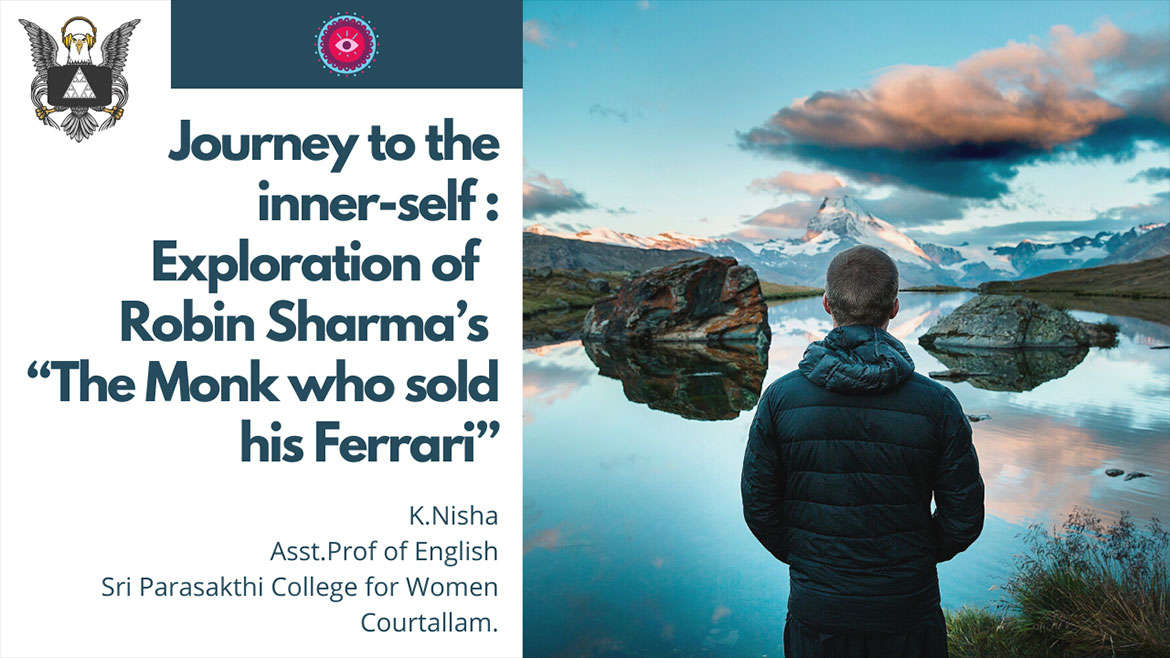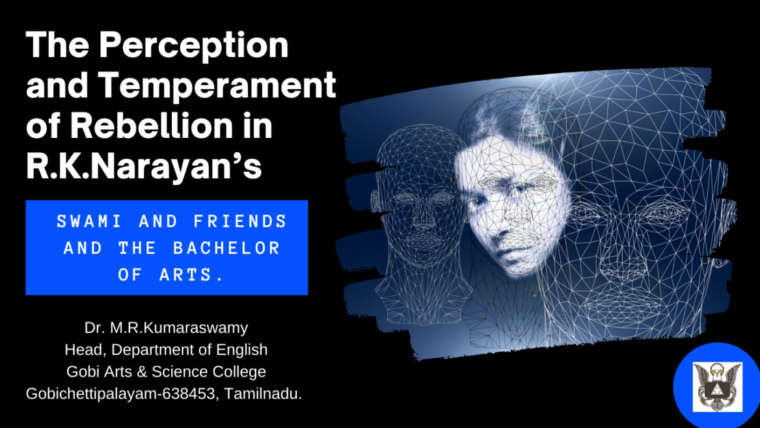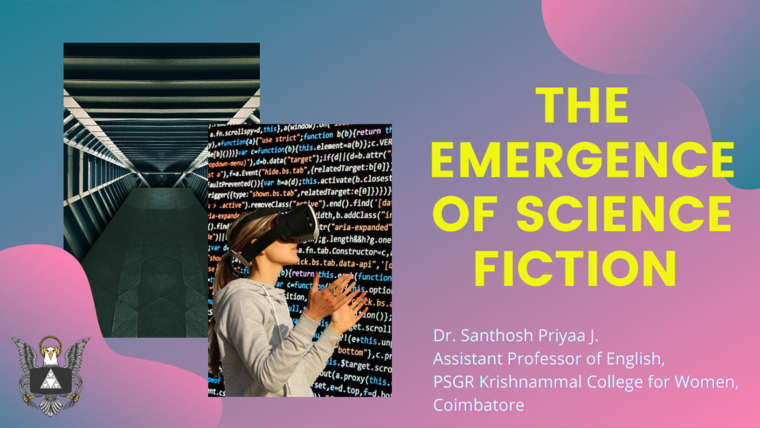Tmt.K.Nisha
Asst.Prof of English
Sri Parasakthi College for Women
Courtallam
Abstract:
Robin Sharma is one of the self help gurus of personal mastery. His works have helped people to know themselves. They have healed people of their inner hurts. His series of books called “The Monk who sold his Ferrari” made a great impact in the lives of many. They have been positively transformed and in turn they try to enhance the world around them. This paper attempts to make an analysis of “The Monk who sold his Ferrari”.
“The Monk who sold his Ferrari” provides ways to travel into the inner self of one’s own mind. It enriches individuals and enhances their personality. Robin Sharma’s works inspires people who are stressed out of everyday routine. There is enormous motivation in this book. It is an elixir or panacea for those who suffer from the maladies of personal problems. This book raised Robin to the heights of success and gave him an identity as a motivational writer. It has been published in many countries in many languages. Robin has published this book as outcome of a ten year research. During this study he has analysed books of many great thinkers, their philosophies and ideologies. His writing mainly focusses on personal and holistic development of an individual.
“The Monk who sold his Ferrari” tells us the story of a famous lawyer Julian Mantle. His only ambition in life is to achieve more; of course he achieves everything through his hard work. But he forgets to take care of his self. One day during a court session he crumple on the floor and undergo a massive heart attack. He was surprised to know from the doctors that he had to take rest if he wishes to survive longer. So he decides to take break from his profession.
Julian sells all his possessions including the Ferrari, leaves behind his family and comes to the holy land of India. He believes that he would get free from his entrapments through spirituality which we can find in India. First he meets Yogi Krishna who guides him to go to the Himalayas where he could find answers for all his questions.
After searching for some days he meets Yogi Raman at Sivana. Yogi Raman surprises Julian by saying that he could liberate himself from his own mind, body and soul. He could even have control of senses through some austere practices. Julian was really impressed and he was ready to undergo any process of self healing.
Yogi Raman becomes his guru and teaches him the ways to ease his mind through some ancient techniques. He also teaches him some virtues on one condition that Julian should teach whoever he comes across what he learnt in Sivana. Soon Julian was able feel a great change happening to himself. Julian transfers all the knowledge that he have gathered from Sivana of to his friend. Rest of the story is the narrative of seven virtues which Yogi Raman taught Julian that would make a human being happy and live peacefully.
Before moving to the virtues Yogi Raman narrated a fable to Julian in which he asked Julian to see a beautiful garden in his mind’s eye. He envisions a beautiful garden which is lush green with the most colourful flowers. The place itself is calm and filled with tranquillity.
At the centre of the garden there is a lighthouse. Suddenly from the door of the lighthouse a Sumo wrestler comes out and wanders around the garden. He is half naked; he has only a pink wire cable around his waist. He sees a shiny gold watch lying on the ground. The sumo wrestler slips and falls down with a heavy sound. He becomes unconscious but by the fragrance of the roses the sumo wrestler wakes up energized. He sees a winding path studded with sparkling diamonds which leads him to a path of perpetual paradise.
First virtue that the Yogi taught Julian was to “Master your mind” (Sharma 71). This was actually practiced by the ancient Indian gurus to attain mastery of their mind, to listen to their inner voice. It led them to a rhythm and solitude which enriched their mind. Thus to take control of one’s own mind is the first step towards spiritual discipline. The magnificent garden symbolises this.
Next virtue he teaches is to “Follow your purpose” (Sharma 92). This could be done by following the discipline of dharma. With this an individual will be able to find his purpose of his life. The lighthouse symbolises this.
Third virtue the Julian taught is “Practice kaizen” (Sharma 143) which means improvement in Japanese language. According to this view one has to constantly improve and change. This is symbolised by the sumo wrestler. “Live with discipline” (Sharma, 158), enhances the individual’s life with strength and power. This will develop self-confidence to the individual. The pink wire cable around the waist of sumo wrestler symbolises this.
“Respect your time” (Sharma 172), symbolised by gold stopwatch is the next virtue which stress the importance of giving priority to our time. He talks about 80/20 concept where we work 20% and get 80% results. This is an ancient rule. We should sacrifice our time meaningfully for doing simple meaningful things .He says that we have to live each day as if it is the last day of our life.
In our journey towards improvement we have to “Selflessly serve others” (Sharma 180) symbolised by fragrant roses. Giving to the needy, poor and the destitute is the most important virtue. This brings at most satisfaction to one’s life. We should live in our present no brooding over the past or to ponder over the future.
“Embrace the Present” (Sharma 197), this is the last and the seventh virtue that the Yogi taught Julian Finally what Julian understands from the Yogi is to never sacrifice the happiness for accomplishments in life. We should live each day as the last day of our life.
The winding path of diamonds symbolises this.
Robin Sharma’s writings take an individual through the process of self transformation. He has embedded the Indian spiritual discipline to improve the self and knowledge. These practices benefits health too. Thus it leads to the holistic development of personality. Robin Sharma extraordinarily accomplishes the indispensable development of barrenness to self-acknowledgment in his works. Through his works the author uncovers human life; he has given understanding about the positive and negative parts of human life. Along these lines, it is an endeavour to break down the expedition towards self-acknowledgment.
Robin Sharma has tried to emphasize the importance of spirituality. Journeying to the interior of one’s own self help the individual develop positive thinking, right attitude and attain peace. All human beings should perform ascetic ideals through spirituality. This will help the individual to transcend the world of problems with ease.
References:
Sharma, Robin. The Monk who sold his Ferrari. Jaico Publications, 2015.
https://www.thriftbooks.com/a/robin-s-sharma/199782/
https://en.wikipedia.org/wiki/Robin_Sharma



